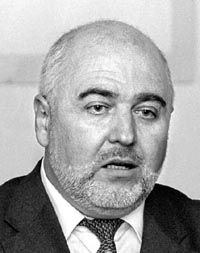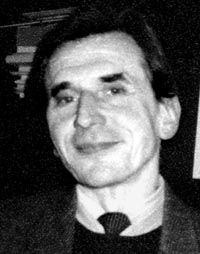The prospective construction of a Jewish community center at Babyn Yar (place of a mass-scale execution of Kyivans by the Nazis — Ed.) has been the point of heated debates in both Jewish and non- Jewish circles for almost six months. What stirred up the debates is not whether Kyiv needs a new community center today but whether it should be situated at the place chosen by those who are going to build it.
Last September the Congress of Ethnic Communities of Ukraine urged the President of Ukraine, the prime minister, the Verkhovna Rada speaker, and the mayor of Kyiv to suspend the Spadshchyna (“Heritage”) project. “The analysis of the situation,” the appeal said, “which may arise following the construction of the center at Babyn Yar proves that this idea will probably be unacceptable for quite a wide circle of the public, representatives of ethnic communities, and political forces.”
This prediction came true immediately after the appeal was made public. Ivan Dziuba initiated the collection of signatures of the well-known Ukrainian public figures in support of the appeal. More than forty individuals have already supported the appeal, including Doctor of History Yury SHAPOVAL and writer, literature researchers and political scientist Mykola RIABCHUK.
“What is Babyn Yar for you?”
Yu. Shapoval: “There are several places in Kyiv associated with mass-scale massacres of people, among them, first of all, Babyn Yar and Bykovnia. These are not just the territories of death but also the places that stir up the memory of the infernal times our people lived through; these are not only part of collective memory but also part of the history of Ukrainian human rights movement, the history of the intelligentsia’s resistance to state- sponsored terror. They are always associated with the names of Viktor Nekrasov, Ivan Dziuba, and many other people who wrested these areas from oblivion and desolation and caused them to stay on in public memory.”
M. Riabchuk: “This is undoubtedly a sacral place surrounded by the aura of sadness and mourning, and it should remain like this.”
“Both of you have gone places and seen the way memory is eternalized at places like this. What can you say to that?”
Yu. Sh.: “My experience is limited: I visited Majdanek and Auschwitz and can affirm that they concentrate their efforts on preserving the authentic surroundings as much as possible. The museums they have are not part of some additional multifunctional structures. I categorically oppose this kind of construction.”
M. R.: “One must exercise utmost caution in the attempt to utilize such a territory for particular purposes. Poland already has this sort of negative experience. The attempts to put up crosses in Oswiencim (former Auschwitz — Ed.) immediately caused acute tension between the Polish and Jewish communities. We must not allow a certain part of society or a people to monopolize the memory of a tragedy.”
“Naturally, all Ukrainians are aware of this. Moreover, the Holocaust is also the tragedy of the Ukrainian people. And Babyn Yar, the symbol of Shoah, is also a place where thousands of people of different ethnicities were exterminated. How can we persuade the public that common memory does not allow us to forget each of those who died, how can we prove that this is just a place for a remembrance prayer?”
Yu. Sh.: “I have read a lot of comments — both positive and negative — on the idea of building a community center at Babyn Yar. I have been recalling all the time Anatoly Kuznetsov’s novel Babiy Yar. The leitmotif of this book, especially of its final part, was to bring it home to the people that nothing at all should be built at this place. If had my way, I would leave Babyn Yar, especially its more or less authentic places, alone.
“Extremists occur among various peoples and sides, and any extremist force — upon my word — can turn to its advantage a certain concept which somebody fervently sticks to. Maybe I look naive, but I would take no steps at all towards any kind of construction.
“Seizing this opportunity, I want to say another thing. I recently watched an interview with Kyiv’s chief architect Serhiy Babushkin who gave sanction to this construction. He said, incidentally, the following about Independence Square ‘gentrification,’ ‘Suppose you don’t like it, but others do, and so do I.’ It is odd that a person who should (must!) defend ex-officio the laws, principles, and canons of architecture behaves as if he were at a flea-market: you don’t like this item but I do. Is this the way to discuss things?
“Assuming this sort of attitude to Babyn Yar, one might as well say that you don’t like this because you are left, right, and so on, but we do like it. This is not a criterion to form the basis of this kind of actions.”
M. R.: “Yes, this is a dubious idea from the architectural viewpoint, and we know that a lot of such ideas were and are being implemented in Ukraine. But there is also a political aspect here. We have already mentioned the negative Polish experience. This compels us to be very cautious in solving this kind of problems. It is easy to provoke but very difficult to resolve a conflict or friction in this case. I think one must think twice before making a decision. I am calling for maximal caution.”
“If the Babyn Yar construction project is to be abandoned and common sense to prevail, will this perhaps be interpreted as a sign of Ukrainian anti-Semitism? For instance, Professor Rudolf Myrsky writes that ‘the establishment of a Holocaust research and public outreach center at the Lviv Polytechnic, in the city called in the West ‘the ideological center of post-Soviet anti-Semitism,’ is of a serious political significance and manifests an essential turning point in public opinion towards overcoming Judophobic stereotypes and forming interethnic tolerance.”
Yu. Sh.: “As a historian, I want to say that any point can be stretched as one pleases. For example, many forget that the majority of the jurors who acquitted Beilis were Ukrainians, but they do remember other negative events. Our institute also has a Holocaust research center, but it occurs to none of the associates to tout it as somebody’s merit, for it was set up because there is a problem to be studied irrespective of political expediency. I do not think it is worth paying attention at all to who and how comments on obvious facts. Evgeny Yevtushenko once wrote in his poem Babiy Yar: consider me a Jew! Ivan Dziuba and other human rights champions spoke there from the bottom of their hearts, defying the likely consequences.”
M. R.: “All this is absolutely right, the more so that suspicions about some special anti-Semitism in Lviv or Ukraine in general are totally groundless. No statistics, polls, or psychological and ethnological studies indicate a high level of xenophobia in Kyiv or Lviv. There is no proof. These are concocted propaganda slogans to be taken with a pinch of salt.
“What would be important in the current situation is perhaps the word of Jewish intellectuals. I believe there are wise, thinking, and authoritative people among them, who look into the future and see the delicacy of this matter; it is they, above all, who should shape and state their position. In any case, I hope for this.
“Ukrainian problems are, first of all, the problems of Ukrainians, as well as Jewish problems are, first of all, the problems of Jews, especially when it is about some negative phenomena. For example, I feel shame for the current turmoil in Lviv over Polish burials at the Lychakiv Cemetery. We and some Polish intellectuals have now planned to lay flowers on both the Ukrainian and Polish graves and hold a religious service. To begin this dialog is a duty of the intelligentsia. Do we have such highly- esteemed people? If a similar problem arose with respect to Jewish burials, I would also come out in their defense. But I hope there are judicious and authoritative individuals on the Jewish part, too, who will support the idea that this construction is out of place.”
“Round-table debates is now a very popular thing. Can a round table be organized to discuss and come to terms on this problem? And if you were to organize one, who would you invite?”
Yu. Sh.: “I take a purely pragmatic approach to such occasions. When scholars organize a round table, they usually think over what it is being done for. Non-governmental organizations should also have a constructive concept. What kind of a concept can there be here? I know that, on the one hand, money has been allotted for this construction, there is a group of people ready to implement this idea supported, in a way, by the government. Therefore, we can gather those who are still capable of thinking and exercising caution in the finest sense of the word. All we can really do is state our attitude openly, the way we think.”
“The construction project territory is on the list of national- level untouchable monuments. However, I am sure not all understand the nature, history, and tragedy of this area. What is to be done to make people change their minds?”
Yu. Sh.:“Take this example: in any place of Paris, you can find a historical reference to a famous name or event for whom the street or the monument was named. As time goes by, new generations are coming. Do you think many people know what events is Babyn Yar associated with? I do not think so. There must be information easily accessible to ordinary individuals.”
M. R. “I think most people know about all this but perhaps do not identify the territory. They picture Babyn Yar in a certain symbolic space, they do not associate it with a concrete place or reality. Their consciousness pushes them into non-spatial extra-temporal categories.”
Yu. Sh.: “It may be so. This is also a particularity of human memory because nobody wants to remember tragic things.”
M. R.: “Apparently, this is a major psychological trauma.”
“But is it necessary to establish a memorial or a museum at Babyn Yar? For museums, at least those of history, are not much being patronized now.”
Yu. Sh.: “Well, I cannot agree that museums are not much being patronized. I have some, perhaps limited, experience of visiting modern museums. People patronize museums, and this is an important factor of education. But why not enlarge the existing exposition in the Museum of the History of Kyiv? Why should it be done at Babyn Yar, thus stirring up resentment? For example, when foreign presidents come here, nothing keeps them from venerating the memory of the Babyn Yar victims.
“There are non-governmental organizations which almost professionally study the history of Babyn Yar. I do not understand at all who and why wants to highlight this issue. This has nothing to do with the above-mentioned Lychakiv Cemetery. Here, we cannot divide the graves into Jewish, Gypsy, Ukrainian, and Russian ones. Death made all of them equal, and they must all be remembered.”
I want to add something to all that has been said. There was a Jewish graveyard next to my grandmother’s house in my native Maryupil. Nobody was buried there any more, nobody visited it. We, kids, used to go there to see marble tombstones and play. When grandmother learned about our ‘excursions,’ she said, ‘You shouldn’t go there just to be with it. This is a city of the dead. They live there and they receive us only when we need their help. Besides, every nation has a burial custom of its own — breaching it means hurting the living.’
This was said simply and forever. I wish we all, believers and atheists, would understand and pass to others these simple truths thanks to which we remain humans.








